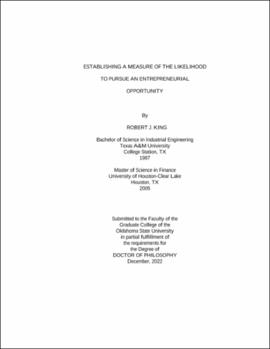| dc.contributor.advisor | Rutherford, Matthew | |
| dc.contributor.author | King, Robert J. | |
| dc.date.accessioned | 2023-07-05T20:56:38Z | |
| dc.date.available | 2023-07-05T20:56:38Z | |
| dc.date.issued | 2022-12 | |
| dc.identifier.uri | https://hdl.handle.net/11244/337856 | |
| dc.description.abstract | Over the past several decades, considerable research has attempted to better understand the characteristics and traits of those who choose to pursue entrepreneurial opportunities over conventual employment. Multiple theories have been drawn upon to assist in our understanding of why individuals choose to pursue entrepreneurial opportunities; the results have been mixed. To assess entrepreneurial phenomena, and since there is some degree of overlap in these theories, I developed a meta-theory after reviewing 10 highly ranked entrepreneurial and management journals. I combined 10 theories from multiple disciplines to show how individual traits and characteristics relate to their pursuit of entrepreneurial opportunities. From this meta-theory, I created the novel construct, the Entrepreneurial Likelihood Pursuit ratio, based on the ratio of individuals’ aspirations to their perceived labor market value. The model incorporates human capital and environment as the antecedes to the Entrepreneurial Likelihood Pursuit Ratio. I hypothesized that the ratio in turn relates to the pursuit of entrepreneurial opportunities. I conducted preliminary interviews with doctoral students to identify antecedents. I then conducted three studies, two instruments, and one archival analysis to validate the measure using a convergent mixed methods design. The instrument includes items pertaining to human capital, environment, career aspirations, perceived labor market value, entrepreneurial self-efficacy, and entrepreneurial opportunity exploitation. I conducted the first study as a general population study. I drew the second sample from undergraduate students at a large, midwestern university. For the third study, I used archival data from the GEM 2018 APS dataset. The results of each study indicated that the Entrepreneurial Likelihood Pursuit ratio did not statistically mediate the relationship between human capital or environment and entrepreneurial opportunity exploitation. I conducted post hoc analyses on Studies 1 and 2 data where I replaced the Entrepreneurial Likelihood Pursuit ratio by career aspirations and then perceived labor market value. For Study 2, perceived labor market value did statistically mediate the relationship between human capital or environment and entrepreneurial opportunity exploitation. | |
| dc.format | application/pdf | |
| dc.language | en_US | |
| dc.rights | Copyright is held by the author who has granted the Oklahoma State University Library the non-exclusive right to share this material in its institutional repository. Contact Digital Library Services at lib-dls@okstate.edu or 405-744-9161 for the permission policy on the use, reproduction or distribution of this material. | |
| dc.title | Establishing a measure of the likelihood to pursue an entrepreneurial opportunity | |
| dc.contributor.committeeMember | Edwards, Bryan | |
| dc.contributor.committeeMember | Tocher, Neil | |
| dc.contributor.committeeMember | Pollack, Jeff | |
| osu.filename | King_okstate_0664D_17945.pdf | |
| osu.accesstype | Open Access | |
| dc.type.genre | Dissertation | |
| dc.type.material | Text | |
| dc.subject.keywords | career aspirations | |
| dc.subject.keywords | entrepreneurship | |
| dc.subject.keywords | labor market | |
| thesis.degree.discipline | Business Administration | |
| thesis.degree.grantor | Oklahoma State University | |
